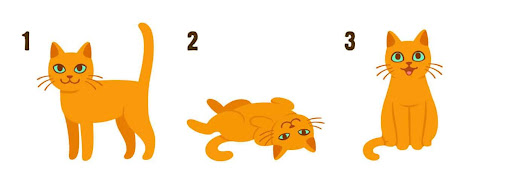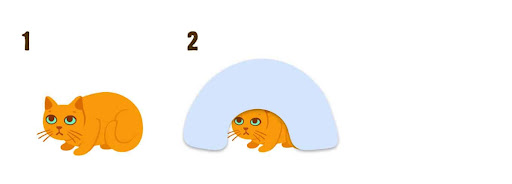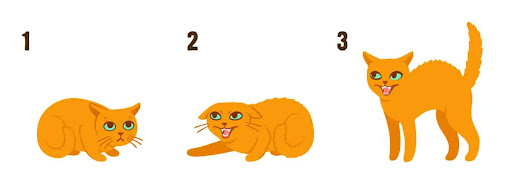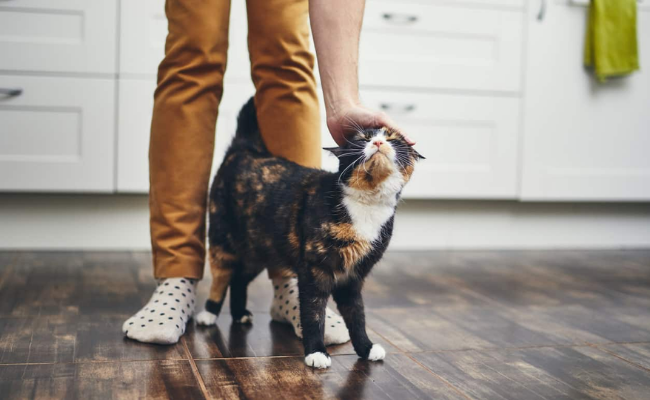Humans are complex creatures — but so are our cats! People who aren’t familiar with cats might say they’re “aloof” or “mysterious,” but understanding a cat’s body language simply takes knowing what to look for.
Cats naturally don’t have many facial muscles, which is why some people might think of them as cold and haughty. Dogs have many more muscles in their faces, so it’s much easier to tell from their expressions when they’re feeling heightened emotions.
When it comes to deciphering a cat’s behavior, context is key. Factors like where the cat is, who or what else is in the vicinity, what the cat ate most recently and anything happening nearby can all impact a cat’s behavior. All feline body language and actions should be considered as parts of a bigger picture — sometimes, one behavior can mean totally different things in different contexts! For example, when a cat faces away from you, it could either be an invitation to touch them or a warning to back off.
Happy or Relaxed Cat Behavior
It’s fairly easy to tell when a cat is happy — their eyes are bright, their posture is relaxed and they almost look like they’re smiling. That said, a cat’s version of happiness can look much different from a human’s and includes some rather odd behaviors.
Purring: This is the most recognizable sign of a happy cat. While the exact physical dynamics are complicated, cats can produce a soft, rhythmic, continuous rumbling or vibrating in their throats when they are feeling content. But purring can also be a coping mechanism for illness or pain, so be aware of other context clues that may point to discomfort.
Slow blink: Cats squeeze their eyes shut sleepily when they feel comfortable and happy. If they do this while staring at you, they’re giving you their version of an “air kiss.” Try doing it back to them to return the message — hey, you’re speaking cat!
Kneading: Also known as “making biscuits,” cats express contentment by flexing and pushing their front paws alternately against soft surfaces, almost as if they are kneading bread. Nursing kittens knead their mothers to stimulate milk production, and many cats carry this behavior into adulthood. The combined behaviors of kneading, drooling and purring is officially termed “smurgling.”
Trilling: Along with the classic meow, cats make a variety of other noises to communicate with humans and each other. A friendly cat may trill or chirp to “greet” their human; this is a sound mother cats often make to communicate with their kittens. A trill sounds like a short, louder, higher-pitched purr.
Head butts: Undetectable to us, cats have scent glands on their foreheads, lips and cheeks that only other cats can smell. Cats will rub these parts of their faces on objects they wish to mark as their own. This behavior is called “bunting”; take it as a compliment when a cat bunts you, as they are telling you and other cats that you belong to them.
What Does My Cat’s Posture Mean?
If you’re still mystified by your cat’s behavior, not to worry! Here’s an easy visual guide that can tell you what your cat is feeling at a glance.
Happy or Relaxed
● Posture: Muscles relaxed, either standing, sitting or lying on side
● Tail (standing): Held upright, tip curled slightly
● Tail (sitting or lying down): Outstretched, relaxed
● Eyes: Pupils dilated, slowly blinking or squeezed shut
● Ears: Neutral position or turned forward
● Mouth: Closed or tongue protruding slightly (also called a “mlem”), whiskers bent forward, purring and/or drooling

Scared or Anxious
● Posture: Crouched low, tense muscles, may hide
● Tail: Tucked tightly against body or puffed up
● Eyes: Wide open, pupils dilated
● Ears: Turned sideways or swiveling back and forth
● Mouth: Closed firmly or open and hissing with teeth bared

Aggressive
● Posture: Arched back, raised fur, body turned sideways or directly toward stressor
● Tail: Held high, fur puffed up or thrashing back and forth
● Eyes: Narrowed, pupils constricted
● Ears: Straight out to the sides or flattened against head
● Mouth: Open, teeth bared, hissing or snarling

While cats and humans may not speak the same language, learning to understand your cat’s unique behaviors can be incredibly rewarding. In their own way, your cat may even come to appreciate the effort — you’ll know by their affectionate head butt!
To read the full article on How to Read Cat Body Language: Behavior, Posture and More as it first appeared on the RAWZ Natural Pet Food site, please visit: https://rawznaturalpetfood.com/how-to-read-cat-body-language/ERE







